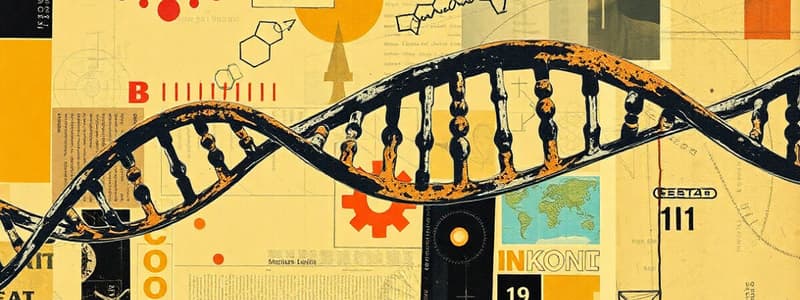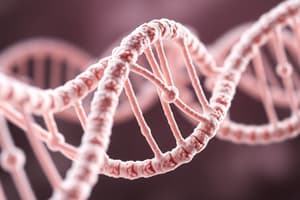Podcast
Questions and Answers
What is the initial process of gene expression that occurs in the nucleus?
What is the initial process of gene expression that occurs in the nucleus?
- Transcription (correct)
- Translocation
- Replication
- Translation
Which part of RNA's structure allows it to have multiple distinct shapes?
Which part of RNA's structure allows it to have multiple distinct shapes?
- Nucleotide subunits
- Phosphodiester bonds
- Flexible backbone (correct)
- Double-stranded nature
What is one of the primary functions of messenger RNA (mRNA)?
What is one of the primary functions of messenger RNA (mRNA)?
- Participates in RNA splicing
- Forms the structural framework of ribosomes
- Transports amino acids to ribosomes
- Carries genetic information from DNA to ribosomes (correct)
Which of the following statements about RNA is NOT true?
Which of the following statements about RNA is NOT true?
How do cells utilize the fixed set of DNA they possess?
How do cells utilize the fixed set of DNA they possess?
What is the primary function of DNA in living organisms?
What is the primary function of DNA in living organisms?
What is the central dogma of molecular biology?
What is the central dogma of molecular biology?
Which of the following correctly describes the structure of DNA?
Which of the following correctly describes the structure of DNA?
What are the basic subunits that make up DNA?
What are the basic subunits that make up DNA?
In the context of genetic inheritance, which statement is true?
In the context of genetic inheritance, which statement is true?
Which process follows DNA transcription in the expression of genes?
Which process follows DNA transcription in the expression of genes?
What role do nucleotides play in the structure of DNA?
What role do nucleotides play in the structure of DNA?
Why is DNA considered a universal medium for storing genetic information?
Why is DNA considered a universal medium for storing genetic information?
What characterizes a charged tRNA?
What characterizes a charged tRNA?
Which structure of proteins involves the sequence of amino acids?
Which structure of proteins involves the sequence of amino acids?
What happens during the formation of a peptide bond in protein synthesis?
What happens during the formation of a peptide bond in protein synthesis?
Which factor is responsible for moving the tRNA during elongation in protein synthesis?
Which factor is responsible for moving the tRNA during elongation in protein synthesis?
Which of the following is NOT a type of post-translational modification (PTM)?
Which of the following is NOT a type of post-translational modification (PTM)?
What is the role of hydroxylation in post-translational modifications?
What is the role of hydroxylation in post-translational modifications?
In which protein structural level do alpha helices and beta-sheets appear?
In which protein structural level do alpha helices and beta-sheets appear?
Which of the following statements about eukaryotic ribosomal units is correct?
Which of the following statements about eukaryotic ribosomal units is correct?
What components make up each nucleotide?
What components make up each nucleotide?
Which base is found in DNA but replaced by another in RNA?
Which base is found in DNA but replaced by another in RNA?
Which of the following bases are classified as purines?
Which of the following bases are classified as purines?
What term describes a nucleotide that lacks a phosphate group?
What term describes a nucleotide that lacks a phosphate group?
What is the significance of the sugar-phosphate linkages in DNA strands?
What is the significance of the sugar-phosphate linkages in DNA strands?
What is the primary reason for Thymine's presence in DNA as opposed to RNA?
What is the primary reason for Thymine's presence in DNA as opposed to RNA?
What functional groups make up the backbone of a DNA strand?
What functional groups make up the backbone of a DNA strand?
What distinguishes the structure of purines from pyrimidines?
What distinguishes the structure of purines from pyrimidines?
What does the directionality of DNA chains indicate?
What does the directionality of DNA chains indicate?
Which base pairs correctly according to DNA pairing rules?
Which base pairs correctly according to DNA pairing rules?
What type of bond holds nucleotides within an individual strand of DNA?
What type of bond holds nucleotides within an individual strand of DNA?
What characterizes the structure of DNA as a double helix?
What characterizes the structure of DNA as a double helix?
What is the approximate length of DNA from chromosome 22 if laid out as a continuous double helix?
What is the approximate length of DNA from chromosome 22 if laid out as a continuous double helix?
How is human DNA organized within the nucleus?
How is human DNA organized within the nucleus?
What type of bond connects individual nucleotides across different DNA strands?
What type of bond connects individual nucleotides across different DNA strands?
What is a misconception about the condensation of DNA into chromosomes?
What is a misconception about the condensation of DNA into chromosomes?
Flashcards are hidden until you start studying
Study Notes
DNA structure
- DNA stands for deoxyribonucleic acid and is made up of nucleotides.
- Each nucleotide has a sugar molecule (deoxyribose), a phosphate molecule and a nitrogen-containing side-group, or base.
- The four bases are Adenine (A), Guanine (G), Cytosine (C), and Thymine (T).
- Thymine is replaced by Uracil (U) in RNA.
- Adenine and Guanine are derivatives of purine, whilst Cytosine and Uracil/Thymine are derivatives of pyrimidine.
- A single strand of DNA consists of nucleotides joined together by sugar-phosphate linkages.
- The backbone of the strand is asymmetric, which gives the strand polarity (directionality).
- Guanine pairs with cytosine.
- Adenine pairs with thymine.
- Nucleotides within an individual strand are bonded by strong covalent bonds (phosphodiester bonds).
- Nucleotides between individual strands are held together more weakly by hydrogen bonds.
- The two strands together produce the ‘double helix’.
- DNA is called antiparallel because the strands run in opposite directions.
DNA Location and Structure
- DNA is stored in chromosomes.
- Each chromosome contains long lists of genes.
- The DNA is highly condensed, even though a single chromosome’s DNA is 1.5cm long, the nucleus which holds it is only 6 μm in diameter.
RNA Structure and Function
- RNA is typically single-stranded.
- RNA has nucleotide subunits linked together by phosphodiester bonds.
- The flexibility and self-bonding of RNA can lead to multiple distinct shapes.
- RNA folding is an extensive field of study, with misfolding leading to disease.
- The three most abundant classes of RNA are rRNA, mRNA, and tRNA.
The Central Dogma
- The flow of genetic information is from DNA to RNA to proteins.
Protein synthesis
- The cycle begins with peptidyl-tRNA in the P site.
- An aminoacyl-tRNA binds in the A site.
- A new peptide bond forms.
- The tRNAs and the mRNA are translocated through the action of elongation factor G, which moves the deacylated tRNA to the E site.
- Once there, the tRNA is free to dissociate to complete the cycle.
- The process continues until a stop codon is reached.
Protein Structure
- Proteins are macromolecules made up of one or more polypeptides and additional small molecules (cofactors).
- The four levels of protein structure are primary, secondary, tertiary, and quaternary.
Post-translational Modifications (PTMs)
- PTMs can have significant impact on function e.g. the glucocorticoid receptor (GR, NR3C1) can be phosphorylated at S211 and S226, which has opposing effects on its activity levels.
- Eukaryotic proteins are also subject to a variety of post-translational modification (PTM), such as:
- Phosphorylation
- Methylation
- Acetylation
- Ubiquitination
- Hydroxylation
- Glycosylation.
Studying That Suits You
Use AI to generate personalized quizzes and flashcards to suit your learning preferences.




